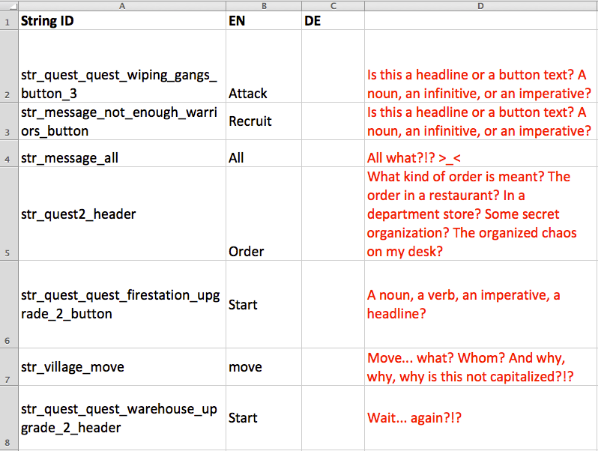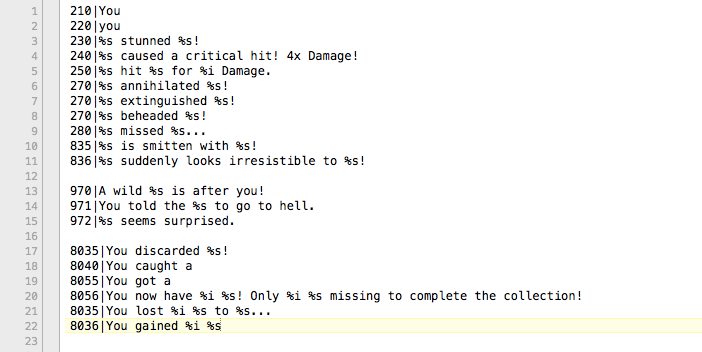Note: I originally wrote this post for LocJAM. However, these tips can be applied to most video game translation projects.
If you're an aspiring game translator, you might have heard of LocJAM, the game translation contest. It is a video game translation competition that is now in its third year. And it's getting bigger and more and more popular, with new languages being added every year. The cool thing is that—unlike in the usual game translator's projects—you have the chance to see your translation in-game immediately. This means that not only can you see your translation in context, but are also able to adjust your text accordingly and fix text bugs right away.
I recommend any aspiring or junior game translator who has some time on their hand to take part in this event (not that localization veterans should stay away). Being responsible for the translation of a whole game and being confronted with the usual—and not so usual—challenges will be great training for your career in video game localization. And above all, it's big fun to take part in a global event like this.
Related post: How to Get the Most out of LocJAM
What else is different compared to a usual project? If you translate for a developer and have any question or uncertainty about a part in the game, you can ask the developer for clarification. If you translate for an agency, you can ask the agency who will then send a collective list of questions to the developer. In the LocJAM however, you might have to make tough decisions, even if you are not sure about something. But isn't gambling a bit fun? :-)
The challenges of translating a video game and questions you might ask yourself:
Missing context: What does this mean?
Being a game translator involves quite a bit of detective work. More often than not, you will find seemingly random words without any helpful context that make no sense, especially if you don't know the game. See what kind of questions are going through my head sometimes.
Luckily, the string ID might offer some insight.
If you are translating files that have already been translated from another language, you might find some guidance there. And if you are really lucky, you have a build of the game (maybe even with text debug, yay!) to investigate by yourself.
Another problem, especially with bigger games, is not knowing which character is currently speaking and whether it is male or female. Though, just like a good novel, if the source text is very well written and consistent, you might recognize the different ways characters express themselves and identify them from their style.
Possible solutions:
Play the game.
Ask your client.
Check and try to understand the string/message ID.
Check the original language, if available.
Search the files for any references to that textbox (character name, item, etc.).
Related post: 12 Actual Reasons Why Some Game Translations Suck
Text limitations: Why are you so damn small?
If you translate into a language like German or French from English, or worse—from a pictographic language like Japanese or Chinese—your creativity and ability to fit the intended meaning into a very limited space will be put to the test. English texts can be 60% longer than Japanese, and German translations are 10–35% longer than their English counterparts.
Unfortunately, not all textboxes are prepared to cope with more text length than the original source language has used. I sometimes have to copy/paste text into a prepared excel file that checks that the pixel length of the translation does not exceed the one of the original source—which might be Japanese or Korean. More commonly I am asked to not exceed the source language length by more than 10%. This leaves us poor German translators with having to find a good solution where sometimes there isn't really one—like abbreviating words to the extreme. If you have played (or translated) the German version of Paper Mario 2 or Oblivion, you know what I'm talking about.
I would like to use this occasion to send out a BIG THANKS to those few developers who consider localization from the very beginning and think of coding scalable textboxes, making our lives oh so much easier. You are the bestest <3
Variables: How to avoid gender issues?
In translations, a variable is placeholder code that will be replaced with the appropriate text when needed. For example, you might have the variable "%CharacterName" in the text, which will be replaced by the name of the character, which might change from localization to localization. Variables can save valuable space and and time. Imagine having to translate 10,000 cells that are identical, only with different character, item, and location name!
But they come with downsides:
1. It might take some effort to figure out what they stand for, since they are not always obviously named
2. Changing the order of the variables might cause the game to crash (if that's the case, your developer will let you know)
3. They might make it hard to find elegant translations if, e.g.
your language uses several articles (German),
has several cases (German or Russian),
changes adjectives according to the gender of the character (Romance languages).
Possible solutions:
Ask your client/check in-game what the variables stand for.
Use less elegant versions that will avoid gender issues and declinations ("You now have %i x %s!" or "You caught the following: ").
Bugs in the source text or code: Is this intended?
Sometimes you are faced with a sentence or word that does not make sense and clearly must be wrong. Even message IDs can be misspelled and mislead you. You might not know what to do but you know that something feels off. Maybe there is a character in the game that is called "Evan". And suddenly you see a character that is named "Evans". This seems like an obvious case of a typo on the dev side (Yes, developers are people too). Another example would be a "Basic Attack" that is called "Simple Attack" in another instance.
In the last LocJAM, the game we had to translate contained a bug in the code that led to a text being displayed in a wrong location (if I remember right). That really bugged me! I spent hours trying to fix it. But not knowing enough about coding, I failed and accepted having this bug in my translation.
You have to decide for every single situation how you will handle it—whether you dismiss it as a bug in the source and fix it on your own, or if you leave it as it is. If you want to play it safe, you stick to the source, even if it might be a bug. You cannot be blamed for someone else's mistake. If you don't mind a bit of gambling, you listen to your guts. The good news is that in a regular project you will be able to ask your client for clarification.
Possible solutions:
Ask your client for clarification.
Trust your logic and fix the bug.
Play it safe and stick to the source text.
Consistency: Will I still remember you in 15,978 words?
Keeping a text of thousands of words consistent is another challenge. Consistency is needed in style, names (characters, items, locations), button texts, menus, and any texts that refer to other texts ("Talk to Lara in Lavena and play the Otto quest in Team Mode to gain the Magical Light Bulb"). Those are usually referred to as "glossary terms". If a menu location is referred to as "Clothes" but is actually called "Wardrobe" the player might get confused as where to go to get himself a new pair of pleather boots.
Possible solutions:
Get used to using a CAT (Computer Assisted Translation) tool. It will remember how you previously translated this term or similar sentences—real time saver!
Develop an internal alarm for texts to immediately recognize texts that should be consistent.
Be obsessive about keeping a glossary (e.g. in an Excel file). Whenever you decide on a translation for any name, button, title, or similar—note it down.
Remember: If you decide to change the translation of a glossary term, you need to change it in all instances, in all files.
Nailing the style: How would they say it?
Bringing the best out of characters and the game universe to help the player immerse into another world is a further challenge, but in my book it is the most fun one. You wouldn't be very fond of a book or movie where everyone speaks the same way or in the same voice (nightmares of pirated Russian movies are coming up). When I play a game or read a book, I personally can forgive the occasional typo or mild text overflow—mishaps happen on all sides. But a badly chosen style can ruin the immersion, the feel of the game, the whole experience.
Possible solutions:
Play the game, read the files, or read as much about the game as possible (there might already be a movie, YouTube videos, or developer interviews out there).
Ask your client for a style guide/character descriptions. If they cannot send you one, create one by yourself with the info you get from the files or game.
Read the text out loud. Read the characters with different voices, intonation, wording.
Create something that you would enjoy reading.
Translation vs. localization: What should I localize? When do I have to stick to the source text? Can I localize too much?
You sometimes will wonder if the player will have a better gaming experience if you translate this character named "Nick" to "Nico" or the village name "Wusthausen" into something that fits your language.
Should I make a corndog a bratwurst? Will Germans understand this reference? In an episode of the Netflix series Fargo, they changed "She is not Pol Pot" into "She is not a dictator" in the German version. I was surprised that Germans are not expected to know about the famous Cambodian dictator who killed many of his people just a few decades ago, considering how many Cambodian friends I grew up with.
Should the game take part in my country, or will moving Tokyo to Frankfurt ruin the gaming experience, maybe for any possible future part of the game series? In my opinion, sometimes localization goes a bit too far. Even though I have to admit that I enjoy this kind of workaround:
When changing the meaning of an item name (e.g. food), make sure it does not appear as a visible item in-game.
When changing a setting, make sure it fits the in-game setting.
If you like to hear about the main game localization challenges in a different way, check out this video!
Extra tips:
Never touch the code!
Use your language-specific special characters (quotation marks, ellipsis, etc.), but respect the developer's instructions and replace them accordingly. Some characters might not be supported and could cause the game to crash.
Related post: Translating vs. localizing game assets
Before you get started, please, pleeease remember that not being a contest winner does not equal failing. Localizing a game requires a mix of technical and creative translation. In creative translations there are many, many possible correct and beautiful versions. And kind of like a finger print, no 2 translated versions of a game will be the exact same.
I am writing this guide for future pros, who I assume are not working with CAT tools.
I recommend the following workflow:
Download and install the game.
Open your text files, to see whether they open correctly.
Open and play the game for as long as it's fun and you can afford time-wise, so you can get a general feel for the style of the game.
Look at your source text. Read it. (It will probably be too time-consuming to read everything, but get a feel of how the strings are organized.)
Start translating: Read the source text to understand its meaning. Read it again to grasp the details. Read your translation (out loud if possible) to make sure that the sentence flows and sounds natural. Re-read your translation, now letter by letter to spot misspellings. If you don't find the best translation, don't break your head; move on—you will come back to this later and inspiration usually comes when you least try. In these cases I write a translation that is correct, albeit not perfect, and try to come up with something better before sending out my work. An average translation is better than an empty cell :)
If you get stuck and just don't know the correct translation, don't worry since you will come back to that string. It might be wise to highlight it in a bright color so you forget about it. Never deliver an empty cell!Play the game to see if your translation fits the context.
Fix any bugs (misspellings, broken code, text overflows, wrong or missing translations) you encounter on the way. Ask yourself if your translation fits the intended style of the game. Is it fun to read and play?Repeat playing and re-writing until you are happy and don't see any more bugs.
And do a final proofreading of your translation. Polish the text, but whenever you change a cell, proofread it again.
Do a Quality Assurance check and search, e.g. for double spaces, two dots and wrong hyphens, depending on your language and the special characters you use.
Do an automated proofreading, e.g. in Microsoft word (copy/paste) the text.
Send your work well before the deadline, taking into account problems that might occur (internet down, diarrhea, getting sucked into Candy Crush and forgetting about it, etc.).
Be happy. You did an amazing job learning about the trade and sent off a complete game translation! Even if you shouldn't be one of the official winners—you definitely win <3
If you liked this article, let me know so I stay motivated to keep on writing <3















![[VIDEO] Adventures in Game Localization](https://images.squarespace-cdn.com/content/v1/547215f7e4b0fbcd35a00b21/1510414634486-TOIPWJS363SIZ6GMO1AD/Concentration-Color-Cube-Play-Puzzle-Magic-Cube-378543.jpg)

